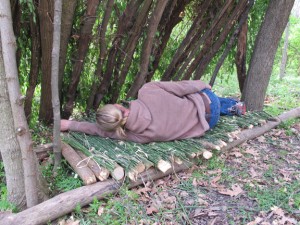Sleeping pads can provide comfort and warmth on camping or hiking trips, but they can also be improvised into valuable resources in survival situations as well. Let’s take a look at a few examples of how you can put them to good use in an emergency and why they represent an excellent addition to any bug out bag.
Insulator
Stand your pad up on its side and curve it into a “C” shape in a wide arc around a campfire. Anchor it in place with some rocks or branches, and you now have an instant fire wall. Not only will the pad help to contain radiant heat from the fire, but it will also soak up some of that heat and provide you with warmth as you lay down and settle in for the night. Another option is to cut a slit in the center of the pad that’s big enough for your head to fit through. Pop it on, and you now have an insulated vest or poncho. You can also cut off a section of the pad, make a slit in the center for your head, and use it as a vest underneath a jacket or bulky shirt.
Cold Feet
If you suffer from the effects of cold, wet feet, or you are in danger of developing frostbite, you can use some of the material from the pad to protect them from exposure. Cut a piece of material that is about twice the size of your foot. Place your foot in the center before pulling the sides up and around the top. Secure it in place with duct tape. This is an excellent source of warmth and comfort, and it can keep feet protected until you can find a warmer environment to rest and recover.
Life Preserver
Tightly-roll up a portion of the pad and secure it with duct tape. You now have an instant personal flotation device. Attach some cordage to the end, and it can be used as an improvised life preserver as well. It can also be used to pull someone up from a steep slope or out of patches of thick mud or quicksand.
Melting Snow
While this may not seem like the most-appealing option, you can use the pad as a way to melt snow without having to build a fire. This is a particularly-effective trick if you have a pad that has dark, heat absorbent foam. Place the dark side up on the ground so it’s exposed to direct sunlight. Scoop up as much snow as you need, and just wait for nature to take its course. Once the water melts, collect it by carefully tipping and bending a portion of the pad so the water can run off into your nearby container.
You can also line the pad with some plastic, before adding snow, to reduce the amount of water that seeps through the foam.
Emergency Splint
Sleeping pads are generally rigid enough to immobilize and protect limbs following an injury. Remove a section of the pad that is big enough to wrap around the limb a few times. Next, trim the edges to make the section as long as the limb before wrapping it securely and holding it in place with some duct tape or cordage.
Rudimentary Shelter
Poke holes about an inch below each corner of the sleeping pad, attach some cordage, and you now have an improvised shelter with guy lines. Secure it in place, and while it may not be that wide, it can be just enough to cover your body and give you some minimal protection from the elements.
